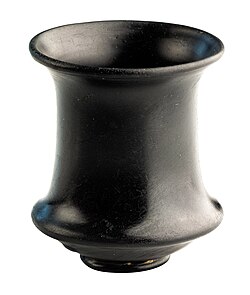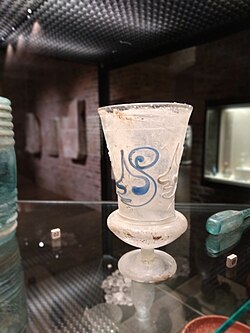

A carchesium ( Latin), carchesion, or karkhesion ( Greek: καρχήσιον, karkhḗsion) was a kind of drinkware of the ancient Greeks and Romans. It is variously glossed as a cup, [1] beaker, [1] or goblet. [2]
Carchesia seem to have had several different forms [3] but were generally somewhat elongated and narrower in the middle than at the top or bottom. [4] They were used for wine in ancient Greece [5] and Rome, [6] as well as milk. [7] They sometimes bore narrow handles. [8] Carchasia were notably used in ritual libation, with Vergil having Aeneas pour out 2 of pure wine, 2 of fresh milk, and 2 of sacred blood over the tomb of his father Anchises. [9] It was also used for pouring out offerings of honey. [1] In late Antiquity, Sidonius associated the vessel with the Chaldeans of Babylonia. [10]
The cup gave its name to the version of a crow's nest used on Greek and Roman ships and to the crane mechanism that could be operated from it. [2] It was glossed in Old English as bune, [11] which appeared repeatedly in the dragon's hoard in Beowulf, probably to denote its antiquity and exoticness to listeners. [12] A large carchesium was given by King Charles the Simple of France to the Abbey of Saint Denis in the early 10th century. [13]
References
Citations
- ^ a b c Yates (1842), p. 197.
- ^ a b Rich (1849), p. 120.
- ^ Whitehouse (1997), p. 191.
- ^ Rich (1849), p. 119.
- ^ Sappho, Frag. 70 or 141.
- ^ Vergil, Georgics, Book IV, l. 380.
- ^ Ovid, Metamorphoses, Book VII, l. 247.
- ^ Macrobius, Saturnalia, Book V, §21.
- ^ Vergil, Aeneid, Book V, ll. 77–78.
- ^ Sidonius, Carmina II, l. 88.
- ^ Frank (2005), p. 410.
- ^ Frank (2005), p. 411.
- ^ Yates (1842), pp. 197–198.
Bibliography
- Frank, Roberta (2005), "Three 'Cups' and a Funeral in Beowulf", Latin Learning and English Lore..., vol. I, Toronto: University of Toronto Press, pp. 407–420, ISBN 978-0-8020-8919-9.
- Rich, Anthony (1849), "Carchesium", The Illustrated Companion to the Latin Dictionary and Greek Lexicon..., London: Longman, Brown, Green, & Longmans, pp. 119–120.
- Whitehouse, David (1997), "130. Cup with Two Handles", Roman Glass in the Corning Museum of Glass, vol. I, New York: Hudson Hills Press, pp. 90–91, ISBN 978-0-87290-139-1.
- Yates, James (1842), "Carchesium", A Dictionary of Greek and Roman Antiquities, London: Taylor & Walton, pp. 197–198.